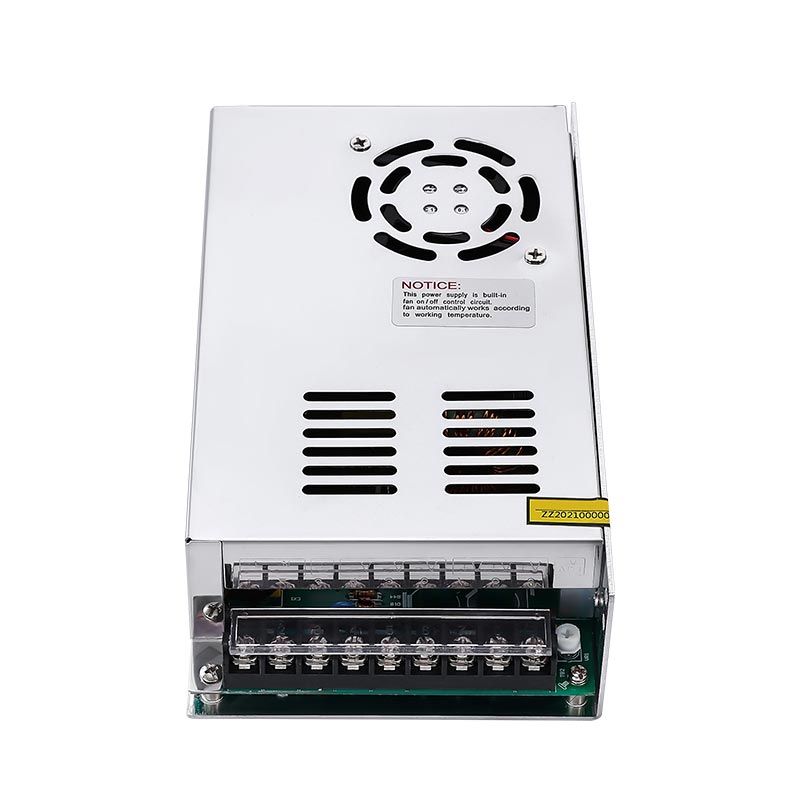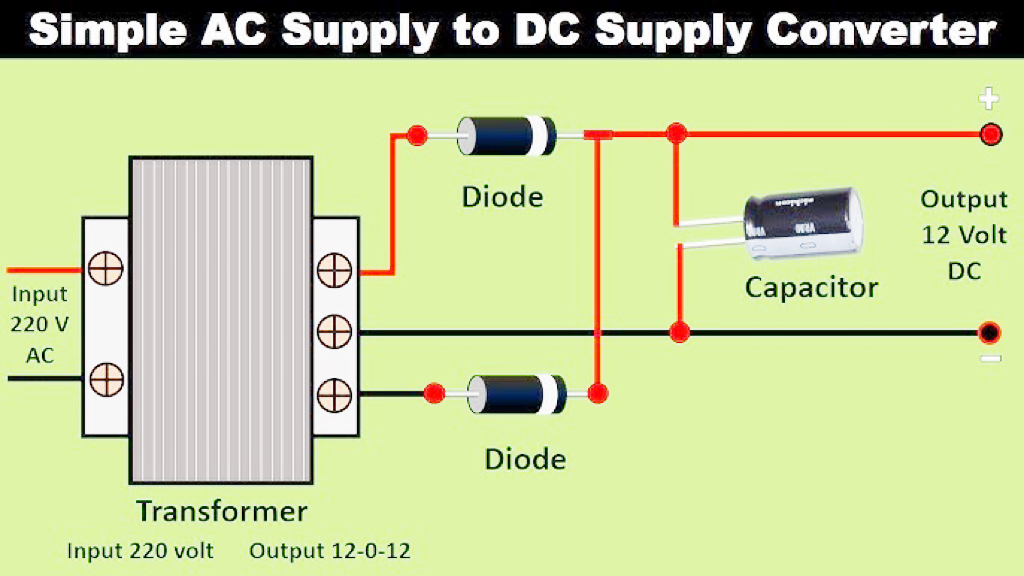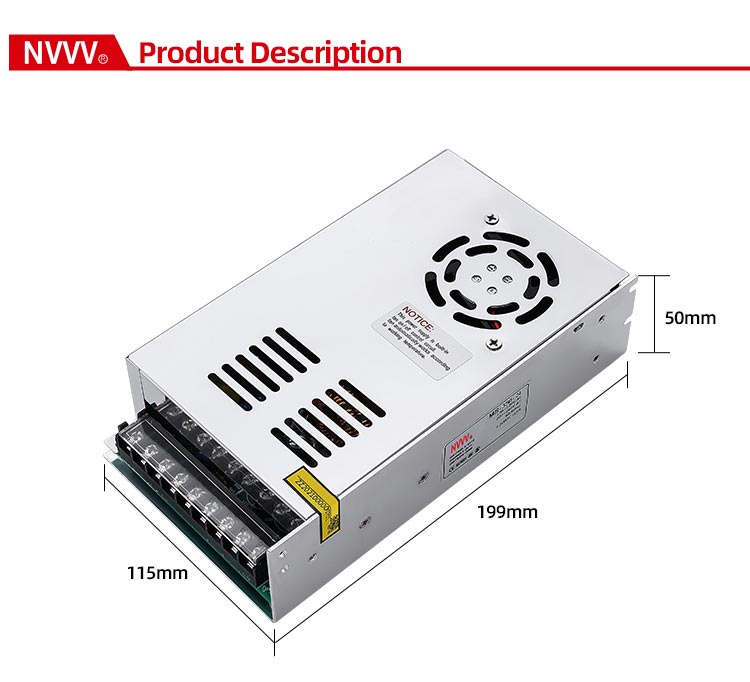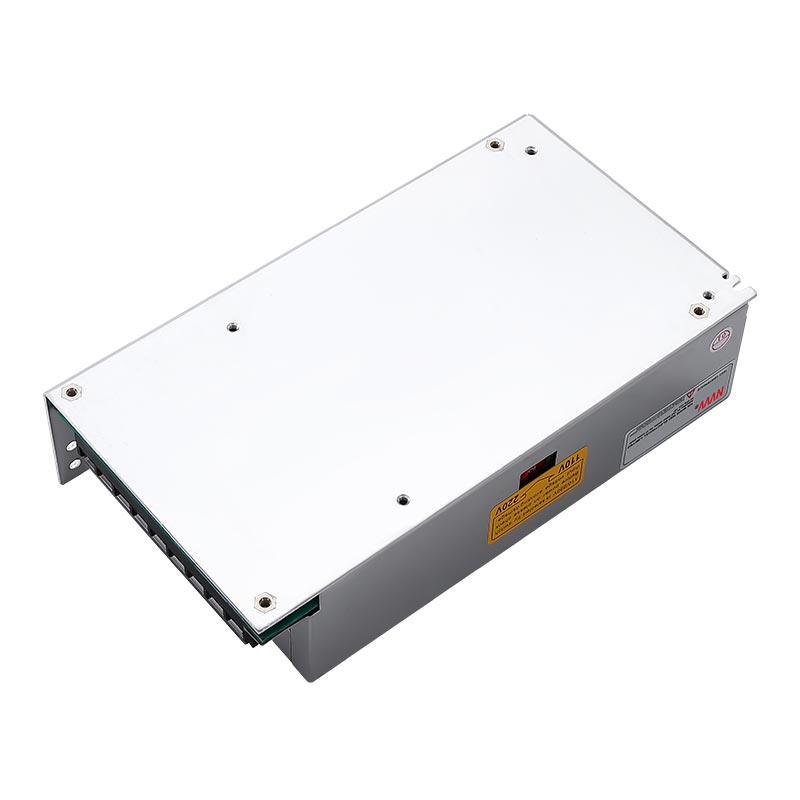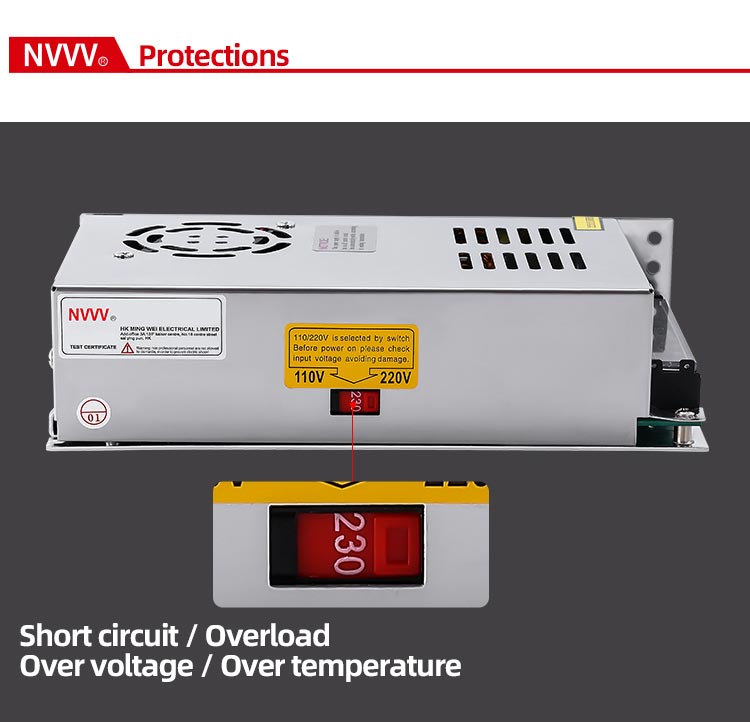What is the Common Failure in SMPS? | Troubleshooting Guide
Switch Mode Power Supply (SMPS) is a type of 24v dc power supply. It is widely used in various electronic devices, especially school laptop network charging cabinets, 3D printers, embroidery machines, etc., due to its high efficiency, small size, and good heat dissipation. However, despite the excellent performance of SMPS, it may also fail under long-term use or harsh environment. So, what are the common failures of SMPS? How to effectively troubleshoot? This article will explore several common failures of SMPS and their corresponding solutions in the form of questions and answers.
1. What is the matter with SMPS not being powered on or unable to start?
When using SMPS, sometimes the power supply cannot be started or is completely powered off. This phenomenon may occur in any application scenario, causing the device to not work properly. Usually, there are many reasons for this problem, which can be specifically checked from the following aspects.
Power cord or plug failure
The most basic reason may come from the problem of the power cord or plug. If the power cord has poor contact, is damaged, or the plug is loose, it may cause the power supply to fail to power on normally. Therefore, first check whether the power cord is intact and the plug is firmly connected. In some old devices, the power cord may be worn due to long-term use. It is recommended to replace it with a new power cord.
Fuse blown
SMPS usually has a fuse inside to protect the circuit. If an abnormal situation such as overload or short circuit occurs, the fuse will automatically blow to prevent further damage to the power supply and equipment. At this time, you can disassemble the power supply casing and check whether the fuse is blown. If it is indeed a fuse problem, replace the fuse of the same specification. However, it should be noted that a blown fuse usually means that there are other problems inside the power supply, so after replacing the fuse, you need to continue to check other possible faults.
Switch tube damage
The switch tube is one of the core components of SMPS. If the switch tube is damaged, the power supply cannot start normally. The cause of the switch tube damage may be overcurrent, overheating or voltage instability. It usually manifests as no response after power on, or abnormal increase in the temperature of the switch tube. In this case, a professional is required to use a multimeter to check whether the switch tube has a short circuit or open circuit problem. If a fault is found, the switch tube needs to be replaced.
Overheat protection
Many SMPS are equipped with overheat protection. When the internal temperature of the power supply is too high, the system will automatically shut down to prevent damage. Therefore, if the power supply is in a high-load operation or poor heat dissipation environment for a long time, the overheat protection may be triggered, resulting in failure to start. The solution is to check whether the cooling system is operating normally, especially whether the fan is operating normally and whether the heat sink is blocked by dust. If there is a problem with the cooling system, it is recommended to clean or replace the fan in time.
What is the reason for the unstable output voltage of SMPS?
In some application scenarios, users may find that the output voltage of SMPS is unstable, which is manifested as high and low voltage, and intermittent restart or shutdown when the device is working. This type of fault not only affects the normal operation of the device, but may also cause damage to the device. So, what is the cause of the unstable output voltage of SMPS?
Aging or damage of capacitors
The capacitor is one of the important components in the SMPS circuit, responsible for storing and releasing charge to smooth the output voltage. However, the capacitor is prone to aging during long-term use, especially in high temperature environments, and the life of the capacitor will be greatly shortened. If the capacitance of the capacitor decreases or is completely damaged, the output voltage will not be able to remain stable. In this case, you can use a multimeter to check the state of the capacitor. If the capacitor is bulging, leaking, or has an obviously insufficient capacity, you should replace it with a new capacitor immediately.
Voltage feedback circuit failure
SMPS relies on the voltage feedback circuit to monitor the output voltage and maintain voltage stability by adjusting the duty cycle of the switch tube. If the components in the feedback circuit are damaged, such as the failure of the optocoupler or error amplifier, the power supply cannot properly regulate the output voltage, resulting in voltage fluctuations. At this time, professionals are required to check the key components in the feedback circuit and replace the corresponding components after the fault is found.
Grid voltage fluctuation
In some areas with poor grid conditions, input voltage fluctuations may directly affect the output voltage of the SMPS. Although the switching power supply has a certain input voltage regulation range, if the grid voltage fluctuates too much and exceeds the regulation range of the SMPS, the output voltage will naturally not be able to remain stable. The solution to this problem is to use a voltage regulator to stabilize the input voltage and ensure that the SMPS can operate within a reasonable input voltage range.
Excessive output load
When the output load of the SMPS exceeds its rated power, the output voltage may become unstable. For example, the user may power multiple high-power devices at the same time, causing the power supply to overload. At this time, the power supply will experience a voltage drop, and even the device cannot start normally. The solution is to reduce the load and ensure that the output power of the SMPS does not exceed its design upper limit.
Why does the SMPS frequently overheat and shut down?
The overheating problem of SMPS is another common fault manifestation. Long-term overheating operation will not only reduce the service life of the power supply, but may also cause equipment damage or fire hazards. So why does the SMPS frequently overheat and shut down? How to solve this problem?
Poor heat dissipation
Poor heat dissipation is one of the main causes of SMPS overheating. SMPS generates a lot of heat when running. If the heat dissipation system cannot effectively dissipate heat, the heat accumulation will cause the power supply temperature to rise. Especially in the case of high ambient temperature or poor ventilation, the role of heat sink and fan is particularly important. The solution is to check whether the fan is working properly, clean the dust on the heat sink, and replace it with a larger heat sink or add an additional fan if necessary.
Unreasonable power supply design
Some inferior or low-cost SMPS may not consider heat dissipation problems or save costs when designing, resulting in an imperfect internal heat dissipation system. If the thermal design power (TDP) of the power supply is insufficient, or the layout of components is unreasonable, the heat cannot be effectively dispersed, and overheating problems will occur frequently. In this case, it may be necessary to replace a better SMPS, or provide a better heat dissipation environment for the power supply during installation.
Excessive load
The workload of the SMPS directly affects its heat generation. When the power supply works at close to full load or overload for a long time, the components in the circuit will generate a lot of heat, causing the power supply to overheat and shut down. In this case, the user should try to reduce the load of the equipment to ensure that the workload of the SMPS is within a reasonable range.
Fan failure
For SMPS with fans, the normal operation of the fan is crucial. If the fan is aged, damaged, or stuck by foreign objects, the heat dissipation effect will be greatly reduced, causing the power supply to overheat and shut down. Regularly checking whether the fan is operating normally and cleaning dust and foreign objects in time can effectively extend the service life of the SMPS.
Is it normal for the SMPS to make noise when starting?
Many users may notice a buzzing or high-frequency howling sound when the power supply starts when using SMPS. Is this noise normal? Does it indicate that there is a problem with the power supply?
Transformer core vibration
One of the core components of SMPS is the high-frequency transformer. When the transformer is working, its core may produce tiny vibrations due to the electromagnetic force, resulting in a slight humming sound. Normally, this sound is normal, especially when the power supply is just started, the vibration of the core will be more obvious. However, if the sound becomes abnormally loud or lasts for too long, it may mean that the transformer core is loose or damaged. At this time, it is necessary to check and tighten the core and replace the transformer if necessary.
Inductor component noise
The inductor is also one of the important components in SMPS. Sometimes the inductor will make a whistling sound or a sound similar to the flow of current during operation. This situation usually occurs when the internal coil of the inductor is loose or aged. Although this noise does not directly affect the normal operation of the power supply, it indicates that the inductor is in poor working condition. It is recommended to check the inductor in time and replace it if necessary.
Capacitor failure
When the capacitor in the SMPS fails, the current in the power circuit may produce unstable fluctuations, causing the transformer or inductor to emit high-frequency noise. If the noise is accompanied by abnormal phenomena such as unstable power output voltage or device restart, it means that the capacitor may have aged or been damaged. At this time, the capacitor should be checked for bulging or leakage, and replaced in time.
Why does the SMPS have a short circuit fault? How to deal with it?
Short circuit fault is a more serious type of fault in electronic circuits, which may cause the power supply to fail instantly or even damage the entire circuit system. Switching mode power supply is no exception. Short circuit faults will cause the equipment to fail to work properly and may bring safety hazards. So, why does a short circuit fault occur in SMPS? How can we quickly deal with this situation?
Welding problems on the PCB
The circuit board (PCB) of the switching power supply is a complex combination of circuits. Any poor welding, poor contact or poor quality of welding materials may cause short circuit problems. For example, if the solder joints are too close or the solder overflows, it will cause a short circuit between the lines. This type of problem usually occurs in low-quality SMPS or when the solder joints are damaged after the power supply has been repaired many times. Solving this type of short circuit fault requires professional maintenance personnel to check the soldering of the circuit board through a microscope and repair the problematic solder joints.
Component aging and damage
The electronic components used in SMPS, such as capacitors, diodes, MOSFETs, rectifier bridges, etc., will age as the use time increases. When these components age, they may cause internal short circuits. For example, after long-term use, the electrolyte of the capacitor dries up, the capacitance decreases, or there is an internal short circuit, which will cause the overall short circuit of the power supply. In this case, professional tools are needed to test each component, confirm the aged part, and replace it.
Overload use
When the SMPS drives a load beyond its rated power range for a long time, it may cause the component to overheat, causing the component in the circuit to fail and cause a short circuit. For example, when a SMPS with a rated power of 1000W continuously drives a load of 1200W, the MOSFET or rectifier bridge may be damaged due to overheating, causing an internal short circuit. To avoid this situation, it is recommended that users use the SMPS strictly within its power range and avoid frequent overload operations.
Solution
For short circuit failures in SMPS, users can take the following steps to troubleshoot and repair:
· Check the fuse: In the case of a short circuit failure, the fuse in the SMPS will usually blow. Check and replace the fuse of the appropriate specification.
· Check the soldering points on the power board: Use a magnifying glass or microscope to carefully check whether there is an obvious short circuit on the soldering points on the circuit board, and re-solder if necessary.
· Test components: Use a multimeter to test the various components in the circuit, especially the diodes, MOSFETs and capacitors, to confirm whether they are damaged.
· Repair or replace damaged components: Repair or replace the faulty components. If the circuit board is severely damaged, it is recommended to directly replace the new SMPS.
What is the reason for the activation of the overvoltage protection of the switching power supply?
The overvoltage protection (OVP) in the switching power supply is a safety function to prevent the output voltage from being too high and causing damage to the equipment. When the output voltage of the SMPS exceeds the set safety range, the overvoltage protection mechanism will automatically start and cut off the power output to avoid damage to the load equipment. In this case, the power supply stops working and the user will find that the device cannot operate normally. So, what causes the frequent activation of overvoltage protection?
Feedback circuit failure
In the design of SMPS, the voltage feedback circuit is responsible for real-time monitoring of the output voltage and adjusting the working state of the switch tube to maintain voltage stability. If there is a problem with the components in the feedback circuit, such as damage to the optocoupler or error amplifier, the power supply cannot properly regulate the output voltage, causing the output voltage to increase and triggering the overvoltage protection. At this time, it is necessary to carefully check the key components in the feedback circuit and replace them after the fault is found.
Control chip failure
The control chip of the SMPS is responsible for the working logic of the entire power supply, including functions such as voltage regulation and overvoltage protection. If the control chip is damaged internally, the output voltage may not be regulated normally, causing the voltage to exceed the normal range. In this case, the overvoltage protection will be activated frequently to prevent the power supply from outputting abnormal voltage. The solution to this problem is to replace the damaged control chip, but this requires a certain level of technical skills and is recommended to be performed by professional maintenance personnel.
Power supply overload or load mismatch
If there is a problem with the load device and the power consumed exceeds the design range of the power supply, it may cause the SMPS to output abnormal voltage. In this case, the overvoltage protection mechanism will be triggered. Especially when some high-power devices such as motors and air conditioners are started, their instantaneous power demand may far exceed the rated power of the power supply, causing the power supply output voltage to surge. To avoid this problem, users should ensure that the power of the SMPS and the load device matches.
Solution
If the SMPS frequently has overvoltage protection problems, it is recommended that users follow the steps below to troubleshoot:
· Check the load device: Confirm whether the power of the load device matches the rated output power of the power supply to avoid overload.
· Check the feedback circuit: Use professional tools to test whether the optocoupler, error amplifier and other components in the feedback circuit are working properly, and replace damaged components if necessary.
· Replace the control chip: If the control chip is determined to be faulty, it is recommended to contact professional maintenance personnel to replace and debug the chip.
Why does SMPS generate noise? How to reduce noise?
Switched-mode power supply noise problems are also a common phenomenon encountered by users, especially when the power supply is started or working under high load conditions, buzzing or high-frequency howling may be generated. Although these noises do not necessarily directly affect the normal operation of the power supply, they usually indicate that there may be some problems inside the power supply, which deserves the attention of users.
Transformer core vibration
The high-frequency transformer in the SMPS is one of the main sources of noise. When the transformer is working, the core vibrates slightly due to the electromagnetic induction force, generating a buzzing sound. This phenomenon is particularly obvious when the power supply is just started, which is a normal phenomenon. However, if the noise is too loud or lasts for a long time, it may be that the transformer core is loose or the transformer itself is damaged, which needs to be checked and tightened or replaced.
Howling of inductor components
When the inductor component works at high frequency, the current flowing in the coil may produce a howling sound. This noise is usually caused by loose windings or aging of the inductor component. Although this type of noise does not necessarily affect the output of the power supply, it may indicate a degradation in the performance of the inductor. It is recommended to check the windings of the inductor and make necessary repairs or replacements.
Noise caused by output voltage fluctuations
When the output voltage of the SMPS is unstable, current fluctuations in the transformer and inductor components may aggravate the noise problem. If the user finds that the noise is associated with the load status of the device, especially when the noise is aggravated when the voltage is unstable, it means that the power supply may have a poor regulation problem. At this time, it is necessary to check the voltage feedback circuit and test each capacitor and filter component.
Conclusion
As one of the core components of electronic equipment, the switching power supply has excellent performance, but it is inevitable that various faults will occur during long-term use. It is hoped that through the detailed fault analysis and troubleshooting guide in this article, new and old users can better understand the causes of SMPS failures and find solutions. For complex or professional repair work, it is recommended that users contact our NVVV professional technicians to handle it to ensure the safety of the power supply and the normal operation of the equipment. If you have any purchase needs, you can also contact us directly.

